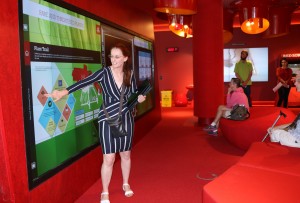Griffith University is home to some of south-east Queensland’s rarest native plants, and Professor Catherine Pickeringwants more people know about it.
Each year, the Professor of Botany from the Griffith School of Environment holds the Rare and Threatened Plant Walk on the Gold Coast campus to highlight both the beauty and fragility of native plants in the region.
Among them is potentially the rarest olive in the world, a native species with only 16 known plants in the wild and eight now growing on campus.
“We also have a stunning bottle tree from Ormeau that only grows close to the Albert and Pimpama rivers,” said Professor Pickering.
“It is an absolutely beautiful tree but there are only 120-200 plants in the wild and we’re making it a feature tree for our campus.
“Although it’s critically endangered because of the encroachment of development, it is one of the best trees we have on campus and we are putting some by the new Aquatic Centre.”
The annual walk, a Friends of the Library event, is now in its second year and, according to Professor Pickering, it is gaining momentum.
“What we are trying to do is educate people about our stunning flora, and the threats that are putting these species at risk of extinction,” she said.
“We’re finding that with school groups and gardening groups that come on campus it not only contributes to a greater knowledge about south-east Queensland native plants but also a recognition of just how vulnerable some of them are to extinction and what we can do to help.
“We’re also trying to encourage family and friends of Griffith staff to know more about the plants we have on campus and the extent of the planting programs.
“We’ve massively expanded the range of native plants on the Gold Coast campus including natives that make great garden plants.
Major threat to natives
“The major threat to these natives in the wild is through land clearing, while for plants such as orchids it is from collecting. In some cases threats come from changes in fire management regimes and now, sadly, climate is in the mix.”
Professor Pickering said the process of identifying endangered native plants wouldbe made easier next year with the introduction of a new app developed in collaboration with Natura Pacific. The groNATIVE app will encourage the use of south-east Queensland native plants in home gardens and for regreening.
“It doesn’t matter if you want an English cottage, Balinese or Hampton-style garden, the app will tell you about different garden styles, along with 400 native species that have been taken into cultivation and which ones will suit those garden styles,” she said.
An existing app, Grows at Griffith, is already available to make it easier to identify 300 native plants on all of Griffith University’s five campuses.
For those who can’t make the annual walk with Professor Pickering, an interactive tour is also available year round at the Gold Coast campus starting at the Red Zone in G40.

